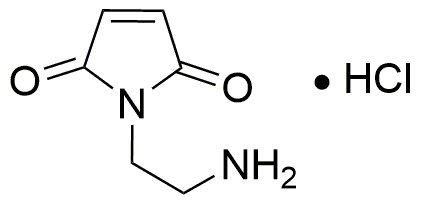N-(2-Aminoethyl)maleimide hydrochloride is widely utilized in research focused on:
- Bioconjugation: This compound is commonly used to attach biomolecules, such as proteins or antibodies, to surfaces or other molecules, enhancing the development of targeted drug delivery systems.
- Diagnostics: It plays a crucial role in the creation of diagnostic assays, particularly in the detection of specific proteins or biomarkers in medical testing.
- Polymer Chemistry: In the field of materials science, it is used to modify polymers, improving their properties for applications in coatings, adhesives, and sealants.
- Cell Biology: Researchers utilize this compound to study cell signaling pathways and interactions, providing insights into cellular functions and disease mechanisms.
- Therapeutic Development: It is being explored for its potential in developing new therapeutic agents, particularly in cancer treatment, due to its ability to selectively target and modify cellular components.
General Information
Properties
Safety and Regulations
Applications
N-(2-Aminoethyl)maleimide hydrochloride is widely utilized in research focused on:
- Bioconjugation: This compound is commonly used to attach biomolecules, such as proteins or antibodies, to surfaces or other molecules, enhancing the development of targeted drug delivery systems.
- Diagnostics: It plays a crucial role in the creation of diagnostic assays, particularly in the detection of specific proteins or biomarkers in medical testing.
- Polymer Chemistry: In the field of materials science, it is used to modify polymers, improving their properties for applications in coatings, adhesives, and sealants.
- Cell Biology: Researchers utilize this compound to study cell signaling pathways and interactions, providing insights into cellular functions and disease mechanisms.
- Therapeutic Development: It is being explored for its potential in developing new therapeutic agents, particularly in cancer treatment, due to its ability to selectively target and modify cellular components.
Documents
Safety Data Sheets (SDS)
The SDS provides comprehensive safety information on handling, storage, and disposal of the product.
Product Specification (PS)
The PS provides a comprehensive breakdown of the product’s properties, including chemical composition, physical state, purity, and storage requirements. It also details acceptable quality ranges and the product's intended applications.
Certificates of Analysis (COA)
Search for Certificates of Analysis (COA) by entering the products Lot Number. Lot and Batch Numbers can be found on a product’s label following the words ‘Lot’ or ‘Batch’.
*Catalog Number
*Lot Number
Certificates Of Origin (COO)
This COO confirms the country where the product was manufactured, and also details the materials and components used in it and whether it is derived from natural, synthetic, or other specific sources. This certificate may be required for customs, trade, and regulatory compliance.
*Catalog Number
*Lot Number
Safety Data Sheets (SDS)
The SDS provides comprehensive safety information on handling, storage, and disposal of the product.
DownloadProduct Specification (PS)
The PS provides a comprehensive breakdown of the product’s properties, including chemical composition, physical state, purity, and storage requirements. It also details acceptable quality ranges and the product's intended applications.
DownloadCertificates of Analysis (COA)
Search for Certificates of Analysis (COA) by entering the products Lot Number. Lot and Batch Numbers can be found on a product’s label following the words ‘Lot’ or ‘Batch’.
*Catalog Number
*Lot Number
Certificates Of Origin (COO)
This COO confirms the country where the product was manufactured, and also details the materials and components used in it and whether it is derived from natural, synthetic, or other specific sources. This certificate may be required for customs, trade, and regulatory compliance.


